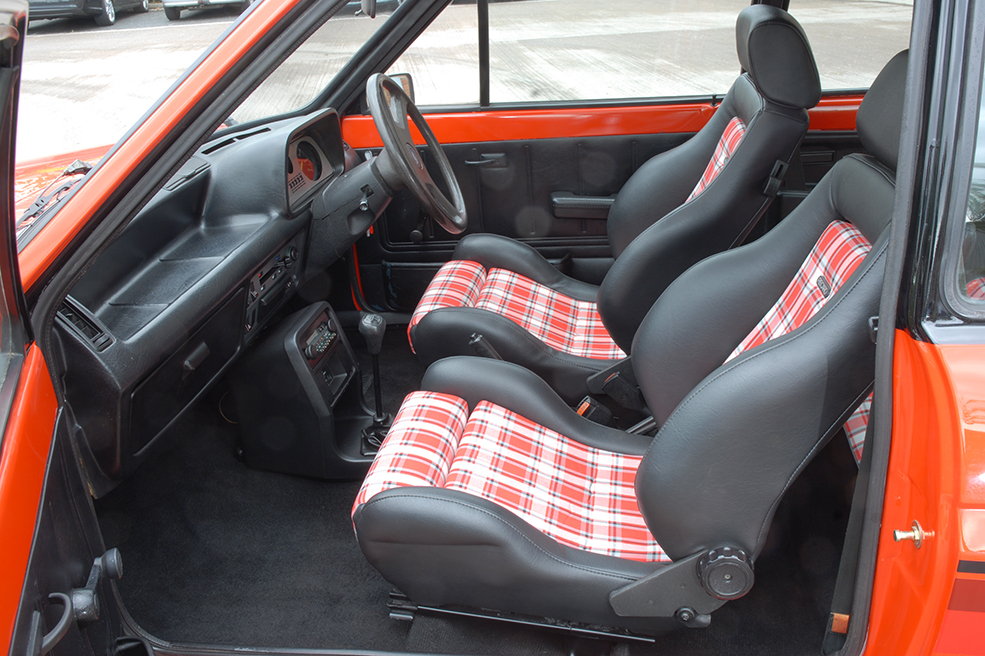Ford’s first supermini and its Mk2 successor are now established yet still relatively affordable classics. Here’s how to buy a Fiesta Mk1 or Mk2
The fast-growing supermini sector was already full swing by the time Ford entered the race with the launch of the Fiesta in 1976. The Volkswagen Polo, Renault 5 and Fiat 127 were already well established but its late arrival didn’t hurt the Fiesta’s chances. The small Ford has rarely dropped out of the top five best-selling cars in the UK and continues to dominate today, with the earlier cars well established as fun and practical classics – especially the Mk1 and Mk2 models covered here.
The Fiesta didn’t arrive in UK showrooms until the beginning of 1977, but Henry Ford II approved the developed of a small economical car as early as 1972 and ‘Project Bobcat’, as it was known, took on greater importance following the 1973 oil crisis. The new car was an ambitious move for its traditionally conservative manufacturer – a new factory in the Spanish city of Valencia was built to shoulder the majority of assembly duties, and Ford stumped up the largest amount of cash it had ever spent developing a new model.
The result was the company’s first-ever front-wheel-drive, transverse-engined car. It was a masterclass in packaging too; the sharp-looking Fiesta actually offered more generous accommodation than the Escort, enhanced with an unusually large rear window and deep side windows that endowed Ford’s self-proclaimed ‘beautiful baby’ with class-leading 86 per cent all-round visibility. It was no surprise that six months after launch the Fiesta was Europe’s fastest-selling car, becoming the UK’s best-selling supermini in 1978, and a million-seller in 1980.
The need to keep the transverse engine as short as possible meant the existing Kent Crossflow engine was initially deemed unsuitable, so Ford came up with a new Valencia version instead with a shorter block, closer bores and a three-bearing crank. Capacities of 957cc and 1117cc were initially offered, but Ford ended up installing a modified version of the ‘full size’ five-bearing Kent Crossflow engine into the Fiesta anyway, in 1298cc guise for the range-topping Ghia and S, as well as in 1598cc form for the US market.
During its production run, nine core models were produced, Base, Popular, Popular Plus, L, GL, Ghia, S, Supersport and XR2, plus a plethora of special editions including the Anniversary, Kingfisher, Millionth, Sandpiper, Firefly, Festival, Bravo, Quartz and Finesse. The attractive Supersport of 1980 used the 1300 Sport as a base coupled with extras from the Series-X accessories catalogue. For 1981, the basic Fiesta was also dropped in favour of Popular and Popular Plus versions, with the whole range face-lifted later that year to feature bigger wraparound bumpers and various interior improvements.
The most exciting Fiesta Mk1 development also occurred in 1981, as the XR2 was launched with a tweaked version of the 1598cc Kent engine, round headlights, sports suspension and a 105mph top speed.
By the time production of the Mk1 ceased in 1983, the Fiesta had dropped to fifth in the UK sales chart but was still boasting sales of over 100,000 per year. Nevertheless, keen to keep things fresh in light of competition from the Metro, Ford came out fighting with the Mk2. The basic underpinnings and bodyshell were largely the same as the previous car, but its rough edges were smoothed off in more ways than one, feeling more refined to drive as well as ushering in softer front-end styling and a revised tailgate.
Along with re-jigging the chassis rails and making a few other structural changes, the rounded bonnet and wings allowed enough space to squeeze in the 1297cc CVH engine from the Escort with its five-speed gearbox. The smaller OHV engines remained in lightly tweaked form, and for the first time there was a 1.6-litre diesel that’s now exceptionally rare.
Initially buyers could choose from the Popular, Popular Plus, L and Ghia, with the sporty XR2 quickly added in 1984 with a 12bhp power improvement on its predecessor. Rather than the old Crossflow, the XR2 was fitted with the same 1596cc CVH engine as fitted to the Mk3 Escort XR3. Curiously, the Mk2 was offered with two dashboard designs – a basic layout for the lesser models, and another for more expensive versions such as the Ghia and XR2.
Further changes included the 1.3 motor being superseded by a 1.4-litre lean burn unit, which was also fitted to the 1.4 S model launched in 1986, designed to appeal to those looking for a sporty option without the XR2 price tag. Ford’s continuously variable transaxle transmission (CTX) was also offered on 1.1-litre cars from 1987. With a large array of models and special editions, the Mk2 proved popular right up until it made way for the Mk3 in 1989. Its best year was 1987, with over 150,000 sold.
Bodywork
Visible rust is likely on the front wings and front panel – particularly the seam between them – the windscreen scuttle, the edges of the doors and bonnet, rear valance, and around the very difficult to repair fuel filler cap. Rear wheelarches are also a favourite grot spot, especially on the XR2 which can hide rust behind its plastic bodykit.
More serious rust is common in the strut tops, under the battery, bulkhead, inner wings and boot floor, plus the sills, outer edges of the front footwells and chassis rails. The sills tend to suffer the most on sunroof-equipped cars, as this is where the often-blocked drain channels are.
Pattern inner and outer sills, wings, front panels, rear arches, rear panels and various repair sections are all available from Magnum Panels for both the Fiesta Mk1 and Mk2, as are Mk2-specific inner wings tops, battery trays and lower front crossmembers. Ex-Pressed Steel panels also makes a host of Ford-approved panels for both models, such as sills, bulkhead sides/A-posts, battery trays, sills, floorpans and boot floors. New old stock panels do still surface from time to time too.
Note that there are differences between the shells on the sportier models and those of lesser models. For instance, on the Supersport and XR2, the body has a slightly different rear panel pressing to make room for the larger 6×13-inch spare wheel, while the Mk1 XR2 uniquely had a pair of reinforcing plates glued and bolted to the chassis rails under the front floorpans. Knowing how to spot these differences could help you spot an XR2 that’s been reshelled or faked using a basic Fiesta.

Engine and transmission
The Valencia small bore motors were never particularly smooth and can be all-in at a mere 50,000 miles, signs of advanced wear being blue smoke, heavy breathing, high oil consumption and, in some cases, a reluctance to tick over. A bit of rattle from the timing chain isn’t usually an issue, but don’t ignore an intermittent clacking from the top end as it’s a common sign of broken camshaft followers. Misfires are often sorted with a good service, but they can also be a sign of more serious issues. Often, closed points are a common cause of rough running.
The Kent Crossflow engines are generally strong, but can suffer with a noisy valvetrain and rattling timing chain. More terminal is piston and bore wear, so as with the smaller motors, check for heavy breathing, blue smoke and high oil consumption as indicators.
A worn CVH will also emit blue smoke and breathe heavy, but an oily engine bay can also be down to the commonly-blown rocker cover gasket. A noisy top end can mean that the camshaft is damaged, due to the lifters being sludged up because of infrequently changed oil. Poor running is often caused by a worn distributor that’s advancing too early.
The Fiesta is fitted with either a four-speed BC gearbox, the five-speed BC5 version or the CTX auto. Rumbling means the BC four-speeder’s differential bearings have collapsed, which can only be solved with a rebuild – watch for a jumpy speedometer combined with any oil leaks as indicators.
The gear shift is far from slick, but a reluctance to accept gears is usually down to wear in the linkage. Age and hard use also damage the synchromesh, the obvious tell-tale being a crunching between gears, particularly on the downshift. The oil level plug on early units has a bolt head and can strip the threads of the casing due to over-enthusiastic tightening – later cars had a Torx plug.
The five-speed is reliable and robust, but a noisy fifth is a sign of the input shaft failing. Retro-fitting the BC5 unit into a Mk1 requires modifications to the chassis to allow clearance for the gearbox to fit – the Mk2 had widened chassis rails. Elsewhere, the belt-driven CTX automatic was advanced at the time, but isn’t the most refined and survivors are rare nowadays.

Suspension, steering and brakes
Wear in the rear trailing arms is a common MoT fall, indicated by a clunking from the back end, uneven tyre wear and loose steering. The normal fix is to simply replace the complete assembly. Tired dampers and springs are cheap and easy to replace, while replacing the often-perished track control arm and tie bar bushes can restore steering response. Sloppiness in the steering can also indicate a worn rack. The XR2 got Girling monotube dampers and lowered, uprated springs, but may well have been replaced with inferior parts by now.
Other than rusty brake pipes and inefficient handbrakes that can be tricky to adjust thanks to the complex pulley mechanism, most braking issues are easy and inexpensive to resolve. A vibration under braking is common and means the front discs are warped or contaminated, but discs are cheap to replace, as are wheel cylinders, rear brake shoes and even brake callipers.
Interior and electrics
With so many different models and special editions, there was a huge variety of trim fitted over the years. That means any replacements are scarce for both the Mk1 and Mk2, so it’s best to assume what’s already there is the best you’re going to get. The top of the rear seat is prone to sun damage, while the vinyl seats of basic models are prone to cracking and the plusher fabric ones can go baggy. Cracked dashes on the Fiesta Mk1 is common, especially Ghia models, while un-cut parcel shelfs for both the Fiesta Mk1 and Mk2 command a premium. Damp front carpets point to possible rot in the front footwell or bulkhead.
Simply cleaning earths or connections usually resolves most electrical issues, especially with the rear lights. Damaged headlights can be replaced easily and cheaply. Look for dodgy wiring that’s been added over the years for past stereo and alarm installations.

Ford Fiesta Mk1 & Mk2: our verdict
Thanks to a strong following, good spares availability and that desirable Blue Oval on the bonnet, the Mk1 is now firmly seeded in the classic car world, and the Mk2 increasingly so.
Still relatively attainable by classic Ford standards, an early Fiesta represents a great starting point for those looking to get in on the Blue Oval action. Now’s the time to buy if you’ve got the itch.


















